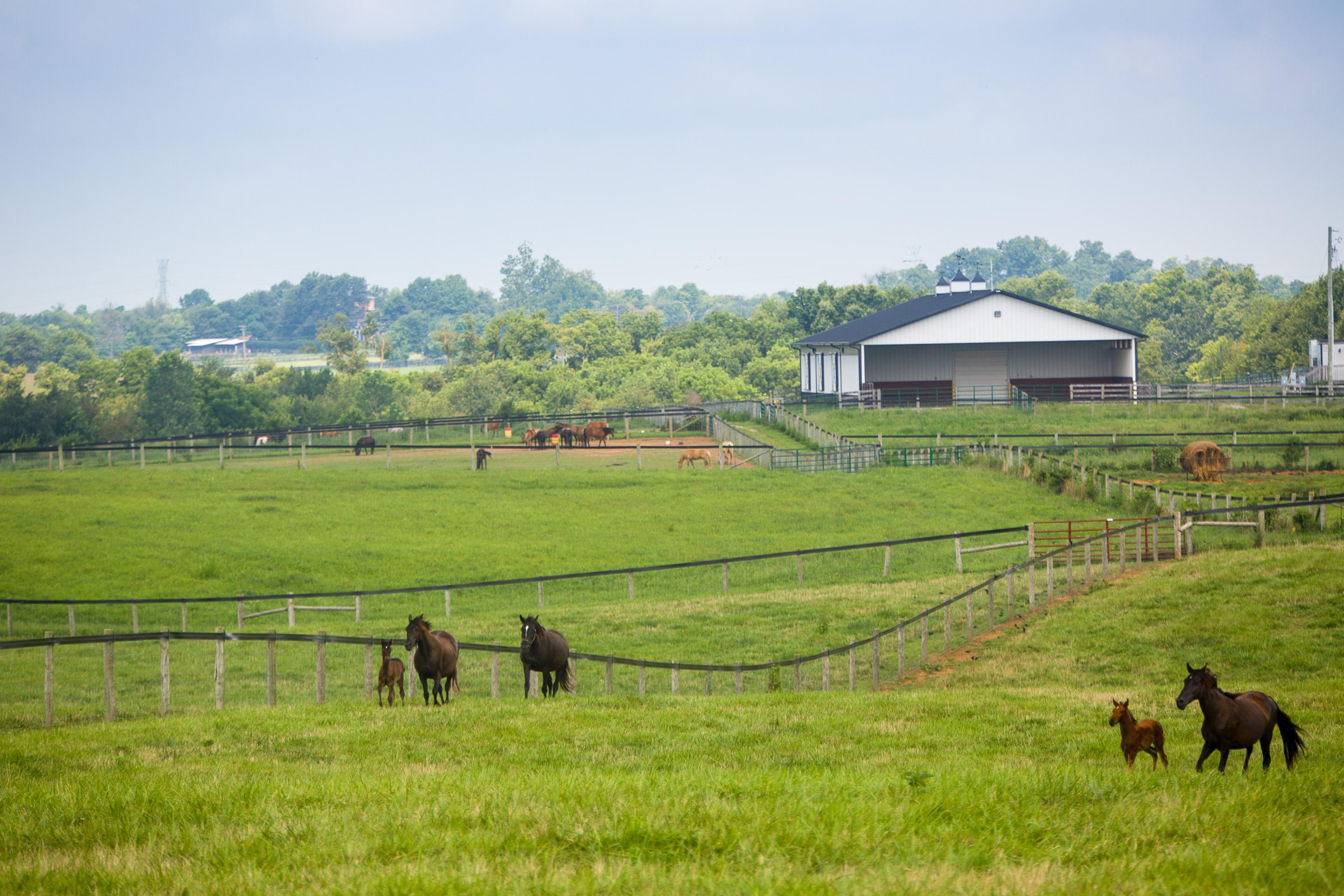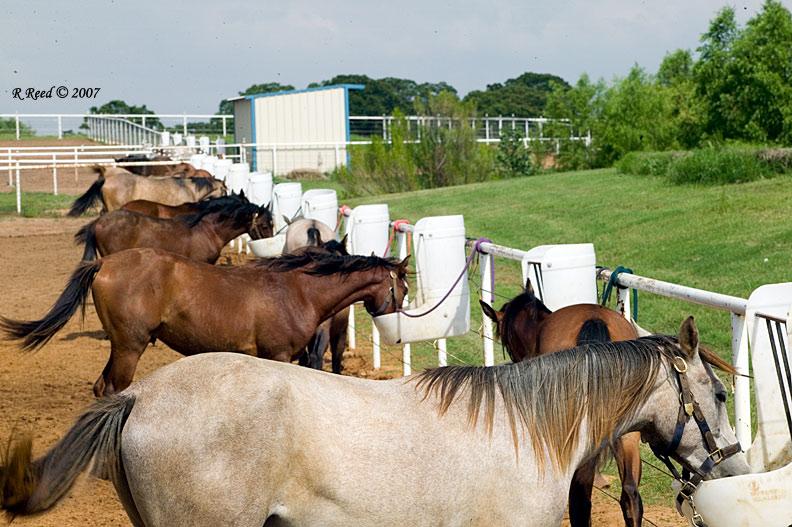Equine Feeding Management: The How & When of Feeding Horses
Equine Feeding Management: The How & When of Feeding Horses
 Author: Laurie Lawrence, Department of Animal Science
Author: Laurie Lawrence, Department of Animal Science
Providing horses with good nutrition is essential for normal growth, reproduction and performance. Horses should receive feeds that are adequate but not excessive in required nutrients. However, just providing the right feeds is often not enough to ensure that horses are receiving optimal nutrition. HOW and WHEN a horse is fed may be just as important as what a horse is fed. The HOW of horse feeding includes the type of feeding system used (group or individual). The WHEN of horse feeding includes the number and timing of meals that a horse receives. Good feeding management should encourage adequate consumption of feed and limit wastage. In addition, good feeding management should promote the safety and well being of horses.
Number & Timing of Meals
In the natural state, horses are grazing animals that may spend up to 60% of their time eating. Grazing and resting periods are interspersed so that grazing periods are rarely separated by more than two or three hours of non-eating behaviors. When domestic horses are kept in a true pasture situation, most will adopt the grazing pattern described for horses in the natural state. However, many horses have limited access to pasture and will receive their nutrient needs from hay and concentrates in a more regimented environment.
In pasture situations, horses may spend 12-14 hours a day grazing. By comparison, stalled horses may consume a typical hay and concentrate ration in two to four hours. When the diets fed to stalled horses are high in roughage, more time will be spent eating than when the diet is high in concentrates. Because horses in stalls often spend less time eating than horses in pastures, they may be more inclined to occupy their time with undesirable activities such as stall vices, or wood chewing. Wood chewing appears to occur more at night in stabled horses and is increased when low roughage rations are fed.
Horses have evolved to consume small amounts of feed several times a day, rather than large amounts of feed once or twice a day. Anatomically, their digestive tract is designed to accommodate small meals, in that the stomach is relatively small. Despite the fact that the horse is more physiologically adapted to many small meals each day, it is not uncommon for feed to be provided only two (or occasionally three) times a day for many horses that are housed in stalls. This feeding practice may be labor efficient, but it may not be the most desirable situation for the horse, particularly if large amounts of concentrate are being fed. The following situations may result when horses are fed two times per day:
- When a large amount of concentrate is fed before the roughage component of the diet, the horse may consume the grain readily and then have a reduced appetite for the hay. The horse may “pick” at the hay or waste the hay by mixing it in the bedding. In either case, the horse will not be consuming the nutrients that are contained in the hay.
- A high and rapid concentrate intake may increase the possibility of digestive disturbances. “Concentrates” are feeds such as cereal grains (oats, corn, barley, etc.) and commercially mixed feeds that are concentrated forms of energy. Concentrates are high in starch. It has been estimated that the maximum amount of starch that should be fed in one meal to a mature horse is 3.5 to 4 lb (1000 lb horse). When higher levels are fed, starch may bypass the small intestine and enter the large intestine where it will be fermented by the microbes in the cecum and large intestine. Excessive concentrate intake has been suggested as a causative factor in the occurrence of colic in horses. A large concentrate meal has also been associated with large shifts in plasma volume and changes in other cardiovascular parameters.
Suggestions for Feeding Schedules
- When large amounts of concentrate must be fed to horses (for example, hardworking horses), divide the daily amount into at least three (preferably four or six) meals each day. Avoid feeding more than 4-5 lb of grain at any one feeding.
- When hay is not fed free-choice, feed the hay before the concentrate. This practice may increase hay consumption and may encourage the horse to eat the concentrate more slowly.
- When horses have poor appetites, offering fresh food frequently may improve feed intake.
- When possible, provide hay free choice. Constant availability of hay may increase the amount of time spent feeding and decrease the amount of time spent in less desirable activities. Placing the hay in a feeder or hay-net will limit waste.
- If hay is fed on the stall floor, divide the daily amount into several feedings to limit waste.
Group Feeding

Many horses will be kept in groups in drylots, paddocks or pastures. In the natural state, horses are herd animals, and thus living in a group is relatively normal from a behavioral viewpoint. When mature horses have access to adequate pasture, water and a salt block, feeding management
is fairly simple. However, pasture alone is typically inadequate for growing horses and lactating mares. In addition, most horses that are maintained on pasture will require supplemental feed in the winter months. This feed can be provided in the pasture, where all horses in the group will compete for the feed. Horses that are kept in drylot situations (paddocks without significant grass) will also frequently be fed in groups. Group feeding is used in many situations because it is labor efficient and does not require the horses to be individually housed. Group feeding can be an effective system for feeding horses but can also have several drawbacks.
One disadvantage of group feeding is that it is difficult to meet the nutrient needs of horses with greatly different nutrient requirements. For example, a yearling requires a ration containing about 12 to 14% crude protein, whereas a mature, non-working gelding only requires a ration containing 8 to 10% crude protein. If the diet meets the needs of the horse with the higher requirements, it will overfeed the horse with the lower requirements.
Social hierarchies are often expressed most openly during feeding periods when the dominant horses may chase the more submissive horses away from the food. In this situation, it is common for the dominant horses to overeat and get too fat. When the supplemental feed is concentrate, overeating may lead to colic and laminitis. The more submissive horses in the group may not receive enough food and thus may lose body weight and condition. In addition, the competition between horses for food in group feeding situations may lead to injuries resulting from kicking, biting, etc.
Suggestions for Group Feeding
- Provide feeder space so that all horses can eat at the same time.
- Observe the horses at feeding time to be certain that all horses have access to adequate feed.
- Space hayracks, feed tubs, etc., far apart to discourage one horse from dominating the entire feeding area. Place hayracks, feed tubs, etc. away from corners, gates and other areas that may pose a safety hazard when horses are interacting.
- If one horse in a group is very disruptive, remove it at feeding time.
- Use hayracks and feed tubs designed for horses. Placing feed in a feeder of some sort will reduce waste.
- Group horses by physiological state (examples: pregnant mares, yearlings, barren mares, etc.), then group horses by body condition (place all fat mares in one group and thin mares in another). Grouping by nutrient need decreases the likelihood of over or underfeeding.
- Observe each horse regularly for changes in body weight and/or condition.
- When horses with different nutritional needs are grouped in a pasture, it may be necessary to individually feed the concentrate portion of the ration. When a barn with stalls is not available, limited amounts of concentrate can be fed with a nosebag. Another solution would be to build a shed with straight stalls. Horses can be let into the straight stalls for feeding and then let out of the shed when all horses are finished. It may be necessary to tie each horse when it enters its stall.
Individual Feeding
A distinct advantage to individual feeding systems is that every horse can receive a ration that has been specifically designed to meet its needs. There is maximum flexibility in the amount and types of
feeds that can be given to each horse. It is also easy to monitor each horse’s appetite and feeding
behavior when they are individually fed. Generally, individual feeding also reduces the opportunity
for injury due to competition for feed within a group. On the negative side, it is more time- and labor-consuming to feed horses individually than to feed them as a group. Further, individual feeding systems usually require some type of facility where horses can be separated, usually a barn with stalls. The horses may be housed in the stall more or less continuously, or just brought into the stall at feeding time. It is not uncommon for horses that are fed in stalls to develop undesirable behaviors at feeding time. For example, horses may kick at partitions, walk the stall or strike at the door in anticipation of feeding.
Some of the disadvantages associated with individual feeding can be minimized with good barn and stall design. For example, the time and labor associated with feeding can be reduced if all feeders are placed at the front of the stalls in a location that can be reached without entering the stall. For example, small doors that swing out into the aisleway can be placed above the grain tub. Swing-out hay feeders are also available. Some people believe that feeding hay from the floor is the most natural situation for horses and that hay racks or hay nets increase the exposure of the horses to dust from the hay. In addition, some horses will remove the hay from hayracks and eat it off the floor. However, hayracks/nets will often decrease wastage of the hay.
The stall design and feeder location may also affect the behavior of horses at feeding. Placing feeders on either side of stall partitions is a labor-efficient design, but it may increase undesirable behavior at feeding, such as kicking. Stall partitions should be high enough to prevent aggressive horses from reaching into adjoining stalls. Some horses do not adapt easily to separation and/or isolation from other horses. Stalls that allow for visual contact across a stable aisle may improve the
response to individual feeding. For horses with poor appetites, visual contact with other horses
may stimulate eating activity.
